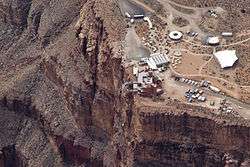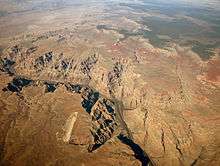Grand Canyon Skywalk
| Grand Canyon Skywalk | |
|---|---|
|
Skywalk from Outside Ledge | |
| Coordinates | 36°0′44″N 113°48′40″W / 36.01222°N 113.81111°WCoordinates: 36°0′44″N 113°48′40″W / 36.01222°N 113.81111°W |
| Carries | Pedestrian |
| Locale | Grand Canyon, Arizona, USA |
| Official name | Grand Canyon Skywalk |
| Owner | Hualapai Tribe |
| Characteristics | |
| Design | Curved pedestrian cantilever bridge |
| Total length | 70 feet (21 m) |
| Width | 10 feet 2 inches (3.10 m) |
| History | |
| Architect | Mark Ross Johnson |
| Opened | March 28, 2007 |
 Grand Canyon Skywalk Location in USA | |
The Grand Canyon Skywalk is a horseshoe-shaped cantilever bridge with a glass walkway in Arizona near the Colorado River on the edge of a side canyon in the Grand Canyon West area of the main canyon.[1] USGS topographic maps show the elevation at the Skywalk's location as 4,770 ft (1,450 m) and the elevation of the Colorado River in the base of the canyon as 1,160 ft (350 m), and they show that the height of the precisely vertical drop directly under the skywalk is between 500 ft (150 m) and 800 ft (240 m).[2]
Commissioned and owned by the Hualapai Indian tribe, it was unveiled March 20, 2007, and opened to the general public on March 28, 2007. It is accessed via the Grand Canyon West Airport terminal or a 120-mile (190 km) drive from Las Vegas. The Skywalk is east of Meadview and north of Peach Springs with Kingman being the closest city of some size.
Design and construction

David Jin, an entrepreneur who had been involved with tourism and the Hualapai Nation for some time, had the idea of extending a platform out over the edge of the Grand Canyon. With the help of architect Mark Ross Johnson, that idea evolved into a rectangular walkway and eventually the "U"-shaped walkway that has now been constructed.
The overall Skywalk width is 65 feet (20 m). The Skywalk length extending out from the post supports closest to the canyon wall is 70 feet (21 m). The outer and inner 32-inch-wide (810 mm) by 72-inch-deep (1,800 mm) bridge box beams are supported by eight 32-by-32-inch (810 mm × 810 mm) box posts having four posts on each side of the visitor’s center, once completed. The eight posts are anchored in pairs into four large concrete footings that are in turn anchored to the bedrock by ninety-six 2 1⁄2-inch-diameter (64 mm) DYWIDAG (acronym pronounced Doo-Wee-Dag) high strength steel threaded rod rock anchors grouted 46 feet (14 m) deep into the rock.
The deck of the Skywalk has been made with four layers of Saint-Gobain Diamant low iron glass with DuPont SentryGlas interlayer. Deck width is 10 feet 2 inches (3.10 m). The Skywalk glass sidings were made with the same glass as the deck, but fewer layers (two) bent to follow the walkway’s curvature. The glass sidings are 5 feet 2 inches (1.57 m) tall and have been designed for high wind pressures.

The Skywalk deck was designed for a 100-pound-per-square-foot (490 kg/m²) live load along with code-required seismic and wind forces. The foundation can withstand an 8.0 magnitude earthquake within 50 miles (80 km).[3] Fine-tuning of the project occurred after a wind loading and pedestrian induced vibration analysis. Two tuned mass dampers were installed inside the outer box beam as well as one inside the inner box beam at the furthest extension of the Skywalk to reduce pedestrian footfall vibration. The walkway could carry 822 people that weigh 200 pounds (91 kg) each without overstress, but maximum occupancy at one time is 120 people.
.jpg)
The Skywalk was assembled on top of the canyon wall in line with its final placement and moved into final position by a jack and roll rig. The Skywalk infrastructure itself weighs a little over 1,000,000 pounds (450,000 kg) without counterweights but including the tuned mass dampers, railing hardware, glass rails, glass deck and steel box beams. At the time of roll-out, the Skywalk weighed approximately 1.6 million pounds (730,000 kg). The process was completed in two days.
The Skywalk glass itself was manufactured and imported from Saint-Gobain Deutsche Glas (Kinon in Aachen) and Glas Döring in Berlin, Germany.
Structural design was provided by Lochsa Engineering out of Las Vegas, Nevada. The contractor was Executive Construction Management also located in Las Vegas, Nevada. Foundation design was aided by John Peck (Geologist), Aaron Hastings, P.E. of Arroyo Engineering Consultants, Inc. (Geotechnical Engineer), DJ Scheffler, Inc., and Crux Subsurface, Inc. of Spokane Valley, Washington.
Astronauts Buzz Aldrin and John Herrington attended the opening ceremony on March 20, 2007.
A National Geographic documentary film on the construction of the Skywalk has been published.[4]
Cornerstone of a larger plan

According to Hualapai officials, the cost of the Skywalk was $30 million.[5] Future plans for the Grand Canyon Skywalk complex include a museum, movie theater, VIP lounge, gift shop, and several restaurants including a high-end restaurant called The Skywalk Café where visitors will be able to dine outdoors at the canyon's rim. The Skywalk is the cornerstone of a larger plan by the Hualapai tribe, which it hopes will be the catalyst for a 9,000-acre (36 km2) development to be called Grand Canyon West; it would open up a 100-mile (160 km) stretch along the canyon's South Rim and include hotels, restaurants, a golf course, casinos, and a cable car to ferry visitors from the canyon rim to the Colorado River, which has been previously inaccessible.[5]
Controversy
Hualapai
Opponents within the tribe view the project as disturbing sacred ground.[6] Supporters within the tribe counter that it is an opportunity to generate much-needed cash to combat serious problems that plague the small 2,000-resident reservation, including a 50% unemployment rate, widespread alcoholism, and poverty.[5] Other tribal members are happy with the Skywalk, but they have expressed concern over future development. They are also concerned about the potential lack of sustainability because the water used in the development is not taken from the Colorado River but trucked in from elsewhere.[5][7] Effective February 7, 2012 certain members of the Hualapai Tribal Council, without prior notice, seized control of the Skywalk which was built and previously run by Grand Canyon Skywalk Development (GCSD), a Las Vegas, Nevada corporation. Currently Grand Canyon Skywalk Development is not in charge of daily operations at the Skywalk.[8] GCSD was awarded 28 million dollars in damages by an arbitration board, which was upheld in U.S. District Court in February 2013.[9]
Environmentalists
People outside of the tribe, including Arizona environmental groups and former National Park officials, have expressed concern about the project's obtrusiveness in the natural environment, considering it a defacement of a national treasure. Former Grand Canyon National Park Superintendent Robert Arnberger has described the development as "the equivalent of an upscale carnival ride," adding that he has been unable to resolve "the apparent conflict between the tribe's oft-stated claim that there is no better caregiver and steward of the Grand Canyon than the tribe, and their approach to the land -- which is based on heavy use and economics."[5] Tribal leaders counter that the 4.5 million people a year who visit the National Park portion are already overburdening an area and, further, that the tribe needs financial income. The skywalk attracts a reported 370,000 visitors per year[10] and the tribe charges for rim-side weddings and stunt jumps, including one by Robbie Knievel. The tribe made a foray into opening a casino but it has not been able to generate sufficient income.[5]
Access and protection
Access to the Skywalk can be made from Las Vegas, Nevada in the north or Kingman, Arizona in the south, via Highway 93. The routes converge (at CR 7/Buck and Doe Rd) near Diamond Bar Road, which was under construction as of December 7, 2009. At the time, Diamond Bar Road consisted of 10 miles (16 km) of an ungraded gravel and dirt road.
There are several packages available for purchase at the airport terminal visitor center. Every package includes parking at the terminal and shuttle bus transportation to the two scenic viewing areas, and the Hualapai Ranch. As of 2015, the final 9 miles (14 km) of county-maintained road to the attraction has been paved [11] and is now accessible to everyone.[3] In addition to admission, visitors may purchase professional photographs of their visit to the Skywalk in the gift shop, as personal cameras are not allowed on the Skywalk itself. Along with other personal property, they must be stored in a locker before entering the Skywalk.[12] This policy often leads to frustration among visitors, who perceive the pricing of these photos, and the tour to the Skywalk itself, as too high. This has given the Skywalk the reputation of a Tourist trap.[13]
References
- ↑ Yost, Mark. Close to the Edge, Wall Street Journal. 2007-04-10.
- ↑ Acme mapper: USGS topographic map
- 1 2 Bryant, Kathleen (2008). Grand Canyon (4th ed.). Berkeley, CA: Avalon Travel. pp. 150–151. ISBN 1-59880-146-5.
- ↑ NationalGeographic.com
- 1 2 3 4 5 6 Cart, Julie. "Grand Canyon Skywalk opens deep divide". Los Angeles Times. 2007-02-11.
- ↑ Grand Canyon glass Skywalk opens. BBC. 2007-03-20.
- ↑ Denniston, Wendy Yanagihara, Jennifer (2008). Grand Canyon National Park (2nd ed.). Footscray (Vic.): Lonely Planet. ISBN 1-74104-483-9.
- ↑ "Arizona tribe votes to take over management of Grand Canyon Skywalk".
- ↑ "Court upholds $28 million award in Grand Canyon Skywalk case".
- ↑ Wagner, Dennis (19 February 2013). "Grand Canyon Skywalk judgment could devastate tribe". USA Today. Retrieved 6 September 2014.
The Skywalk, about 130 miles northwest of Flagstaff, opened to international media coverage in 2007 and reportedly attracts about 370,000 visitors annually.
- ↑ "Hualapai Tourism skywalk FAQ page". Retrieved 2013-11-02.
- ↑ "Hualapai Tourism skywalk site\". Retrieved 2013-11-02.
- ↑ "Skywalk reviews @ Tripadvisor\". Retrieved 2016-09-20.
External links
| Wikimedia Commons has media related to Grand Canyon Skywalk. |
- Official website
- Photo and video reviews
- Washington Post Photo Gallery
- Robbins, Ted, "Sneak Preview: The Grand Canyon Skywalk", Morning Edition, National Public Radio, March 21, 2007.
- Discovery Channel construction photos and video report. (Video requires broadband Canadian ISP connection).
- Grand Canyon Skywalk price and visitor information.

